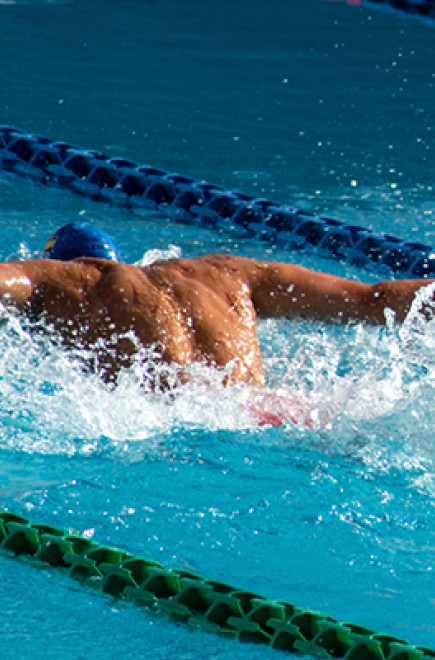Advice From a Pro: Grow Your Vegetables and Herbs in Containers, With Albert Mondor
Regarding its Urban Agriculture Policy, the Town of Mount Royal can count on the special collaboration of Albert Mondor, horticulturist, biologist and resident of TMR. His tips on gardening will help get Townie households on the right track in creating and maintaining their vegetable garden, throughout the summer.
Creating your Urban Veggie Garden
By Albert Mondor, horticulturist and biologist
Are you eager to follow the huge urban agriculture trend this summer by growing your own vegetables and herbs, but don’t have any land? No problem, you can still grow your basil and tomatoes in pots on your patio or balcony. Here are a few tips and suggestions to get the most out of your urban container garden.
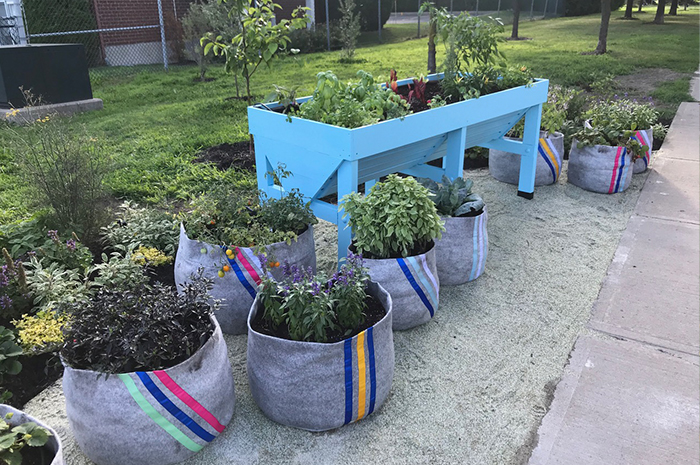
Above: Growing edible potted plants is easy and accessible to everyone! (Credit: Albert Mondor)
You Can Grow Almost Anything in a Pot!
To start, to grow plenty of vegetables and herbs, they should ideally be placed in a sunny spot, away from any trees. Although some vegetable plants like Swiss chard and carrots can tolerate some shade, most vegetables need at least six hours of sunlight per day.
Also, most vegetable plants can be grown in containers, even carrots and potatoes. However, the vegetables best suited for container gardening are those with edible leaves, such as Swiss chard, spinach, kale and lettuce. Potatoes thrive in pots as well, but make sure you plant them in a container that’s at least 45-cm deep. You can also grow root vegetables like carrots in deep containers, and cucumbers, beans and peas do well in pots.
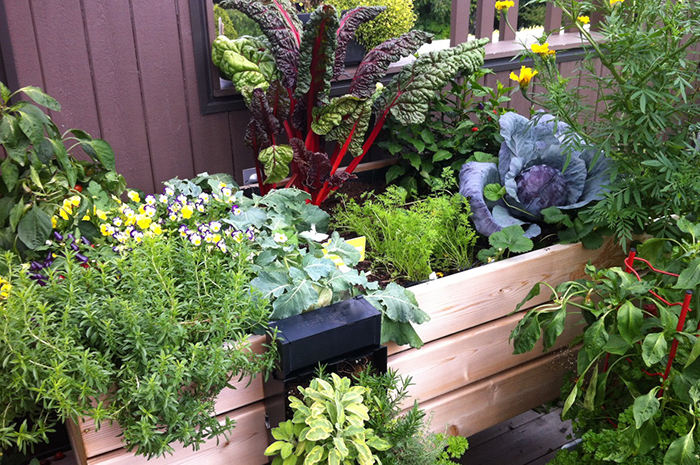
Above: Herbs and leafy greens, like Swiss chard and kale, are some of the easiest edible plants to grow in containers. (Credit: Albert Mondor)
On the other hand, if you want to grow tomatoes in a container, it’s best to opt for a compact shrubby or drooping cultivar that produces small fruits, such as Tiny Tim and Tumbler. However, indeterminate tomato cultivars—which look more like vines—can also be grown successfully in large pots. You can also grow eggplant and bell pepper cultivars that produce small fruit, like the Lunchbox or Mini Bell varieties.
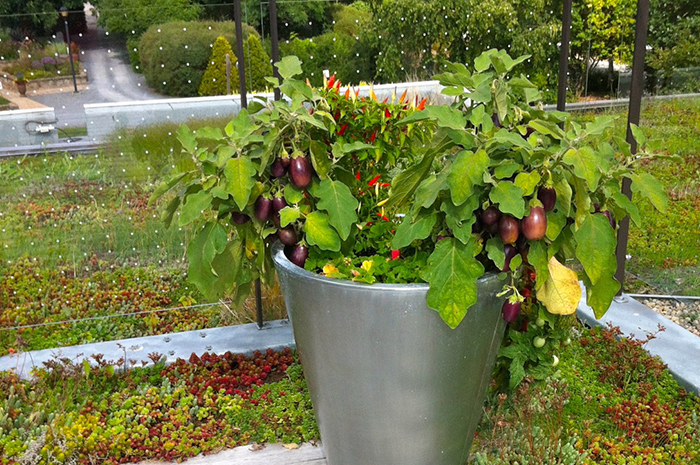
Above: There are many eggplant, pepper and small tomato cultivars specially bred to grow in pots. (Credit: Albert Mondor)
Most herbs are also easy to grow in containers. Among the herbs that grow best in pots are chives, tarragon, lemon balm, mint, oregano, parsley, savory and thyme. Basil can also be grown in pots but it needs more heat and a little more care. Cilantro, on the other hand, does not grow well in pots. When exposed to intense sunlight, the soil around its roots dries up regularly, causing it to bloom and produce seeds very quickly. Once it germinates, it must be harvested very quickly, which means that you will need to plant seeds over and over.
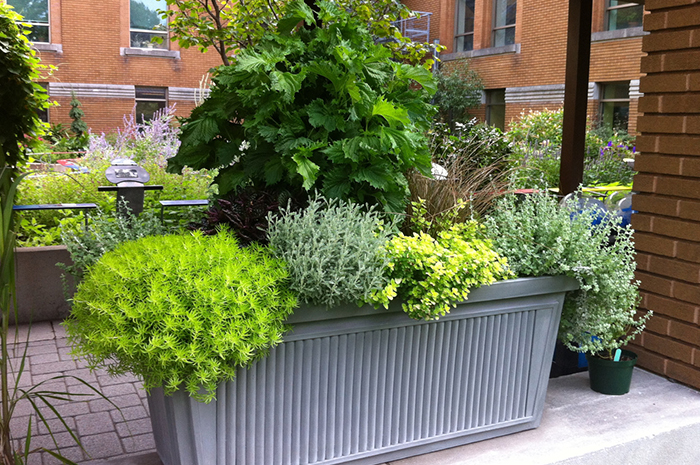
Above: Most herbs thrive in containers. (Credit: Albert Mondor)
The Bigger the Pot, the Better the Harvest
It’s best to plant edible plants in larger containers so that their root systems can benefit from maximum space, water and nutrients. This is absolutely essential to growing demanding tropical vegetables, such as eggplants, cucumbers and tomatoes. Additionally, since these tropical vegetable plants need plenty of heat, darker pots are the best choice.
There are many kinds of pots made with various materials, such as terracotta, plastic, metal, wood and fabric, each with its pros and cons.
Terracotta is made from fired clay-rich soil and has long been a favourite material for flower pots. This porous material provides roots with a steady supply of oxygen and keeps compost at a constant temperature. However, it has the drawback of breaking easily and is not frost-proof. It’s also hard to find large terracotta pots at a reasonable price.
Plastic can also be a good choice since it’s generally inexpensive and resistant. However, some plastic pots may be poor quality and become discoloured over time. It’s also important to consider that manufacturing plastic containers generates greenhouse gases, making it a poor choice from an environmental standpoint.
As for wooden containers, keep in mind that they rot if they come into contact with soil. Be sure to line the inside with extruded polystyrene or a plasticized geomembrane.
In addition to being lightweight and easy to store, fabric pots have a significant advantage over other types of containers because they prevent plant roots from spiralling and promote rootlet growth. They are also generally in the same price range as plastic pots. Some manufacturers even incorporate recycled material into their geotextile pots.
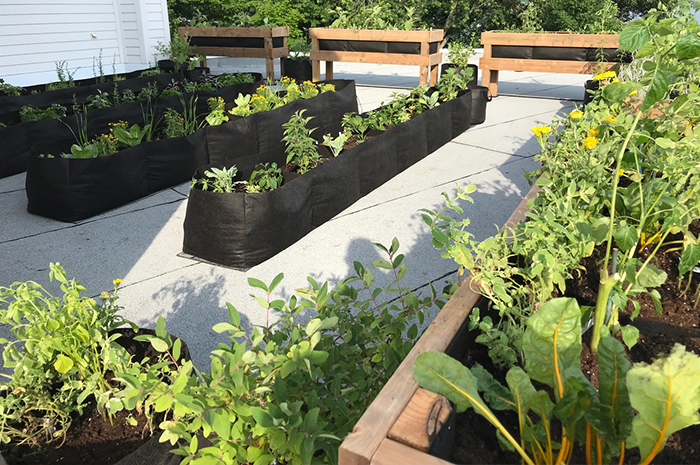
Above: Fabric planters are an excellent choice for growing edible plants. (Credit: Albert Mondor)
Rich Soil
Soil is key when growing vegetables. Rich, healthy soil produces strong, productive plants that are less susceptible to insects and disease. Opt for a rich, light soil with an excellent water and nutrient retention capacity, consisting of compost, peat moss and perlite.
Some commercial soils contain mycorrhizal fungi that adheres to plants and acts as an extension of their root system by drawing water and nutrients in greater quantities. If your soil doesn’t contain any, you can buy boxed mycorrhiza and add it.
Furthermore, for a bountiful harvest, it is also recommended to add a few handfuls (about 100 mL per plant) of natural granular fertilizer rich in nitrogen and potassium (5-3-8 formulation or close to it) when planting eggplant, cucumber, pepper and tomato plants. You can also use fertilizer that is rich in trace elements, such as seaweed fertilizer, on the most demanding edible plants. Leafy greens and root vegetables usually don’t need additional fertilizer since their soil is made up of compost that provides them with all the nutrients they need throughout the season.
